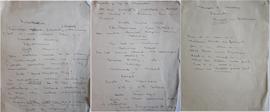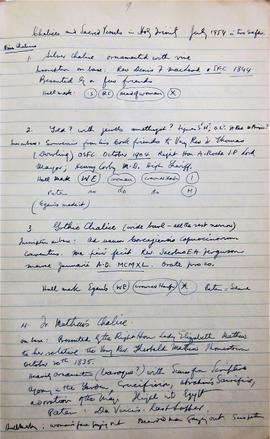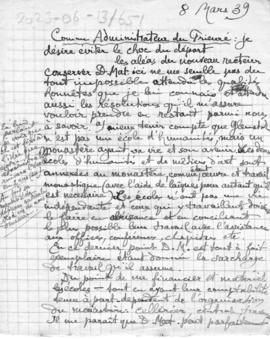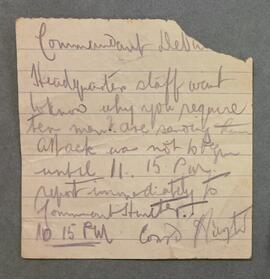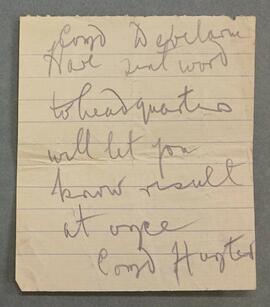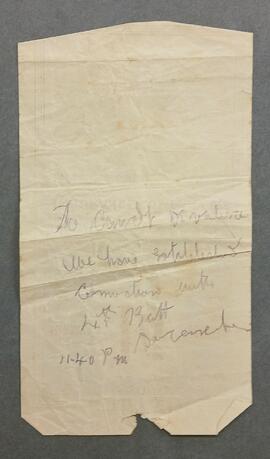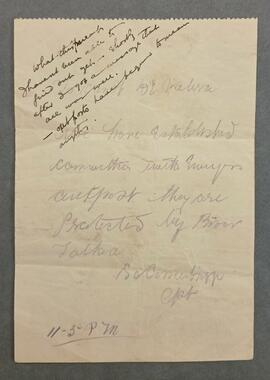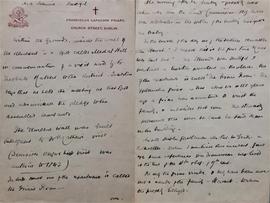Some notes about education in the hand of Patrick Pearse. The notes are undated but were possibly prepared a talk on the subject. The notes conclude with Pearse's transcription of a widely-known poem on public schooling which reads:
‘Ram it in, cram it in
Children’s heads are hollow.
Jam it in, slam it in,
Still there’s more to follow.
Pack it in, smack it in,
What are children made for?
Push it in, crush it in,
What are teachers paid for?’
Notes on chalices and sacred vessels held in Holy Trinity Church 'in July 1954 in two safes'. In total, nine chalices and vessels are briefly described over pp 8-11 in the volume.
...
Notebook belonging to Martin Savage, Irish Volunteer. The annotation on the first page reads: ‘This book belongs to Martin Savage. I [Fr. Columbus Murphy OFM Cap.] got it from him at Richmond Barracks. It contained a list of the names and addresses of all the Volunteers of his company. I tore them out and burned them. Fr. Columbus’. A later note reads: ‘He [Savage] was subsequently killed in the attack on Lord French. Fr. C.’. The notebook also contains thirteen black and white portrait photographs of unidentified individuals and groups. Three of these photographs can be positively identified as Martin Savage. The other photographs may be of his relations. Some of the photographs have a printed company stamp on the reverse: ‘The Franco Art Co., Grafton Studios, 111 Grafton St. … Dublin’.
A note from Commandant Thomas Hunter to Commandant Éamon de Valera during the 1916 Rising. The pencilled note reads ‘Headquarters staff want to know why you require ten men’. It also suggests that an ‘attack was not to begin until 11.15pm’. The message concludes by asking de Valera to ‘report immediately to Commandant [Thomas] Hunter’. The note provides a time of 10.15pm.
A note from Commandant Thomas Hunter to Commandant Éamon de Valera during the 1916 Rising. The pencilled note reads ‘Have sent word to headquarters / will let you know result at once / Commandant [Thomas] Hunter’.
A note sent to Commandant Éamon de Valera during the 1916 Rising. The pencilled message reads ‘We have established communication with 4th Battalion’. An indecipherable signature may be attached. The note provides a time of 11.40pm.
A note sent to Commandant Éamon de Valera during the 1916 Rising. The pencilled message refers to communication being established with an outpost. The note provides a time of 11.30pm. An indecipherable signature of a captain is attached. It adds that ‘They are protected by the River Tolka’. An endorsement (in ink) at the top of the page affirms ‘shortly after I got a message that all was well / outposts have begun to mean anything’.
Note by Fr. Stanislaus Kavanagh OFM Cap. re the existence of an apartment in the Ards House called ‘the Friar’s Room’. It reads:
'The morning after the building and property were taken over from the Land Commission Holy Mass was celebrated in the portion of the building assigned an oratory. In the course of the day one of the fathers remarked to the steward “I expect this is the first time Mass was said here”. The steward was doubtful and mentioned a tradition prevalent … [that] one of the apartments is called “The Friar’s Room”. The explanation given is that about 100 or 150 years ago a friar was accustomed to visit the family and inhabited that room. The steward presumed that when he came, he said Mass in the building'.
Note (possibly by Patrick Pearse or William Pearse) on St. Enda’s School-headed paper. The note refers to the need to obtain the ‘creditors’ money’.
